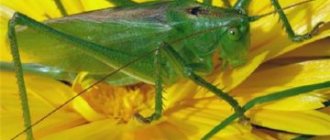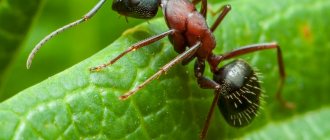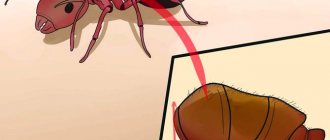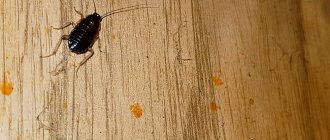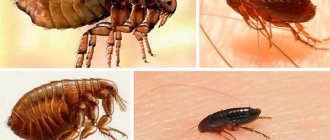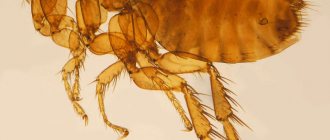Ants, as the most common type of insect, live in almost all corners of the globe, excluding Antarctica and Greenland, as well as individual oceanic islands. They conquered not only forests and steppes, but also deserts, and even the permafrost zone. There are 13,500 species of these insects found in nature, of which 300 species live in Russia. Ants cannot live alone, so they always live in families.
How many years does an ant live?
The life span of ants depends on what species and what caste it belongs to. From birth, the caste of the insect is determined and it does not change throughout its life. Worker ants, queens and males live in one family.
However, not all species of these insects exhibit a strict division into castes. Individuals of black garden and pharaoh ants can change their “specialization” throughout their lives. A newborn ant can take care of larvae and eggs, later - set up a home, and at the end of life - get food.
In addition, the length of an insect's life cycle is affected by its size. It has been noticed that the larger the ant, the more likely it is to live a longer life. The conditions of its life also play a significant role in determining how long an ant will live.
Life depending on your “profession”
Life and reproduction of ants
The ant family is characterized by a clear division into castes; there are more than 10 professions. How many years ants live depends on their type of activity. The longest living individuals are those caring for the queen, cubs, larvae, and performing work inside the nest. They easily live up to the age of 3 years, sometimes 5.
Individuals that are in constant search for food, are engaged in external construction of the house, are exposed to many dangers every day, and therefore risk their lives very often. Their lifespan barely reaches a year. Domestic ants also die from the action of poison, poison offered by humans.
On a note!
How many ants are in an anthill can be approximately determined by the size of their housing. Several million individuals live in a house about 1.5 m high. Below there are 2 times more passages than above the soil surface. The colony loses several hundred individuals every month, and at the same time replenishes the family with new members of society in the same number without damage to the total number.
Red wood ant (Formica rufa)
This insect is called the orderly of mixed forests, since the inhabitants of a large anthill are able to clear an entire hectare of forest from various pests. Ants collect thousands of pupae of harmful insects throughout the day, which are then used to feed ant larvae.
Genetically, the lifespan of the red forest ant is limited to 5 years, but in practice they die much earlier than the period measured by nature. Most often they become prey for birds. Males, after performing their main function, die within a month. The queen can be long-lived if she constantly remains in the anthill.
How is an anthill organized?
Up to 5 thousand individuals can live in an anthill. There is a strict hierarchy in the colony of harvester ants: each family member is busy with his own business. The family consists of a queen - she produces offspring, soldiers - they protect the anthill from dangers and help with harvesting, worker ants - they are engaged in obtaining food and caring for the young. There are also males and females - they mate with each other, creating new colonies.
From the outside, the anthill's shape resembles a volcano
The ground part of the ants' home is a hole in the soil, along the edges of which there is a shaft of earth and debris from the prey they bring. The underground part has a vertical tunnel, from which passages with cameras extend on the sides. In these rooms, ants set up pantries for storing food and “children’s rooms” in which they store larvae.
Meadow ant (Formica pratensis or Messor Structor)
This type of ant prefers to make its home in meadows and forest edges. During the season, winged females leave the anthill twice for the purpose of fertilization. The lifespan of meadow and forest ants is the same.
Ants that rarely leave the anthill have a longer life span than those that are forced to often go outside. The main cause of death of worker ants is attacks by predators, as well as high injury rates.
Factors influencing the lifespan of ants
In addition to specialization and species, the lifespan of ants is also influenced by the following factors:
- region of residence;
- insect sizes;
- nature of the work;
- species features.
It has been observed that in cooler countries, ants live longer. This is explained by the fact that the development time of larvae is extended due to slower metabolism. In addition, in winter, some species hibernate, which also lengthens their lifespan.
Body size is another of the most significant factors. The larger the insects, the longer they tend to live. Accordingly, small ants will live less.
Life expectancy is not least influenced by the nature of the work that a particular ant is assigned to perform. Individuals engaged in the quiet work of renovating their homes and raising the younger generation, as a rule, live a long time. Soldiers and miners die before the allotted time from the jaws of enemies and accidents.
It has also been noted that insects leading a measured, sedentary life are able to live longer than wandering nomads. The high mortality rate from injuries and starvation among nomads probably plays a big role in this.
Interesting facts from the life of ants can be learned from this video:
Pharaoh ant (Monomorium pharaonis)
The pharaoh ant, brought from hot habitats, settles and lives in people's houses. In an apartment, these insects do not build an anthill, but choose separate niches and cavities for their habitat. If pharaoh ants settle in an apartment building, then the number of their colony can reach several thousand individuals, and they will all belong to one family.
These insects have the shortest life cycle. Females usually live no more than 9 months, breeding males have about 20 days, and working individuals no more than 2 months. Despite the short period of existence, insects are capable of reproducing at least 30,000 individuals during this period, which occurs due to the presence of a large number of queens in the nest.
There are slave ants
The connections of different ants with each other are so diverse that even people can sometimes envy them.
For example, in a whole genus of Amazon ants, worker ants do not know how to feed and care for the nest on their own. But they know how to attack the nests of other, smaller species of ants and steal larvae from them. The ants developing from these larvae will subsequently care for other than their queen and soldiers.
In other species, this behavior has gone so far that the queen simply enters someone else’s anthill, kills the queen living there, and the worker ants recognize her as their own and care for her and her offspring. After this, the anthill itself is doomed: from the eggs of such a female, only females capable of capturing the anthill of another species will develop, and with the death of all the working ants, the colony will be empty.
There are also benign cases of slavery. For example, the queen steals several pupae to found a colony, and the ants developing from them help her at the very initial stage of colony development. Further, the colony develops with the help of the descendants of the queen herself.
Tropical ant (Myrmecia gulosa)
Tropical ants can be called long-lived; in bulldog ants, the queen lives not 12 or 6 years, but about 20-22 years; working individuals live up to 5 years.
As entomologists note, the average life cycle is:
- For worker ants, lifespan ranges from 1 to 3 years. Moreover, the lifespan of large individuals is longer than that of small ones, and ants - inhabitants of cold regions live less than their counterparts in the tropics
- In males, the life cycle is limited to several weeks. Their life goal is to participate in mating, and then they are destroyed by the ants of their anthill or become prey to predators. Some species leave the males alive, but only if there are several queens in the anthill.
- The queen can live for about 20 years, which is 10-15 times longer than the lifespan of an ordinary worker ant. During this time, she is capable of producing offspring numbering from 500,000.
Products from the article:
Life depending on gender
Most of the anthill consists of workers - unfertilized females. Such ants live in nature for about a year, although theoretically they can live up to 3 years. This duration is typical for small representatives of our area - pharaonic, black garden, red. The lifespan of larger varieties is somewhat longer. Red forest animals live up to 3 years.
Interesting!
The lifespan of a male ant is much shorter - from 3 months to several weeks. Directly depends on participation in the mating season. After mating, the life of males begins to be counted in days. In 10 days he will die.
The fertile female lives the longest - the queen, the queen of the ant family. For different species, experts give numbers from 5 years to 25. The head of the family does not appear outside, since there is no need for this. Once fertilized, she continues to lay eggs throughout her life. She is looked after properly and fed in the best possible way.
Features of the life cycle of ants
Today, about 14,000 species of ants are known throughout the world, most of which live in tropical latitudes and equatorial jungles. According to rough calculations, insects of the family Formicidae form about a quarter of the total biomass of the animal world, which is a kind of record for living nature. In temperate countries, about 300 species have been studied, which have confidently occupied their natural niche and are actively developing within forests, fields, cities and suburban areas. The only continent on whose territory no traces of ant colonies have been found is Antarctica. This is due to harsh climatic conditions and the almost complete absence of stable food sources.
The ant lives as part of a huge family - a colony, the number of which can reach 1 million individuals. The dimensions of an anthill can vary from a few cm to 1-2 m. Depending on the material used to build a multi-level nest, earthen, woody and deciduous anthills are distinguished. Some species of tropical insects, for example, weaver ants Oecophylla, actively use living tree leaves, connecting them together with very thin threads, similar to a cobweb.
The structure of an anthill is of significant interest to researchers. The total depth of the nest, including underground passages and food storage chambers, can reach 2 m. As a rule, the insects' home consists of small branches, fragments of leaves, pine needles and lumps of soil. With the onset of darkness, the entrances to the anthill are covered with resin, which helps protect the home from moisture, rain and outside intrusion.
Life of an ant community
The small anthill that has been built is constantly expanding. Both its above-ground and underground parts are increasing. Construction never stops, so worker ants work all day long. The structure of an anthill is quite complex and includes not only a lot of transitions, but also the following elements:
- outer covering of branches and leaves;
- room heated by the sun;
- ventilation ducts;
- lower wintering chamber;
- grain storage;
- underground garbage dump;
- the queen's chambers;
- children's;
- storage room for captured caterpillars and insects;
- departments for keeping aphids.
The larger the colony, the more departments there are in such a stationary house. Ants overwinter in deep underground passages. The temperature there does not drop below 3-5 °C. Since ants reproduce continuously in order to constantly maintain the life of the colony, huge communities have several royal chambers. In appearance, any female is a constantly reproducing monster. Large anthills need several queens. The number of queens can reach 5-10 individuals to provide the colony with offspring. The development of the ant depends on the feeding habits of the larval form. Reproduction does not stop for a single day throughout the warm season.
Ant eggs are unique. Representatives of all castes immediately emerge from them, who subsequently build the anthill and perform work for its normal functioning. Working individuals create a nest and care for the new generation. They are small in size. Larger individuals are foragers that participate in the search for food. Another caste is represented by soldiers. Ants attack any creature that poses a danger to the community and are ready to die in the fight against the enemy. It is very difficult to list what ants eat in nature, since these insects are omnivores. The creatures' diet includes:
- any insect;
- juices and pulp of berries;
- seeds;
- carrion;
- some types of plants;
- dew;
- tree resin.
These insects can attack prey of any size. Insects can even cope with predators of the microcosm. An ant bite allows you to create a wound for injecting poison.
From early morning until late at night, foragers scour in search of food. Next, the food goes to the queen, larvae and other members of the colony. These creatures do not need to sleep, but they do not work at night.
Any forager can carry as much as the ant weighs. In some cases, these creatures carry loads that are 5-10 times their own weight. Recently, scientists were able to determine how much an ant weighs after drinking nectar or juice. They refer the nutrient fluid to other relatives. Therefore, the weight of the ant fluctuates significantly.
/wp-content/uploads/2016/12/video.mp4
Representatives of some species can winter even in the harshest conditions, where the cold persists for 9 months a year. How ants prepare for winter has already been studied quite well. Insects clog all entrances and move to the lower sections, where the temperature is maintained, which is not destructive for insects. Ants do not sleep, their metabolic processes simply slow down.
